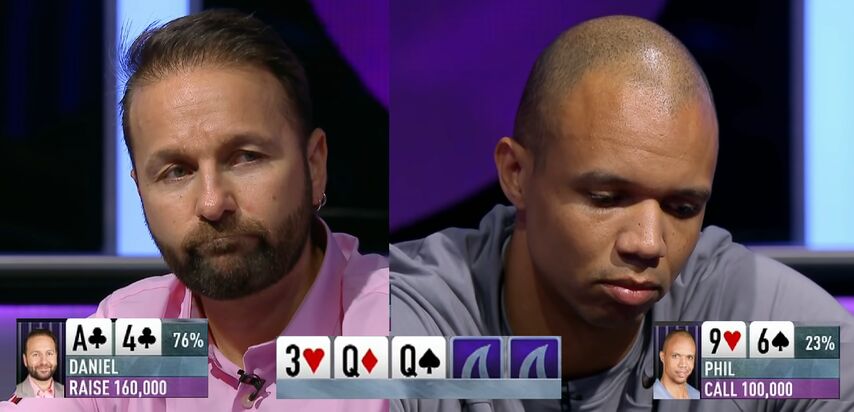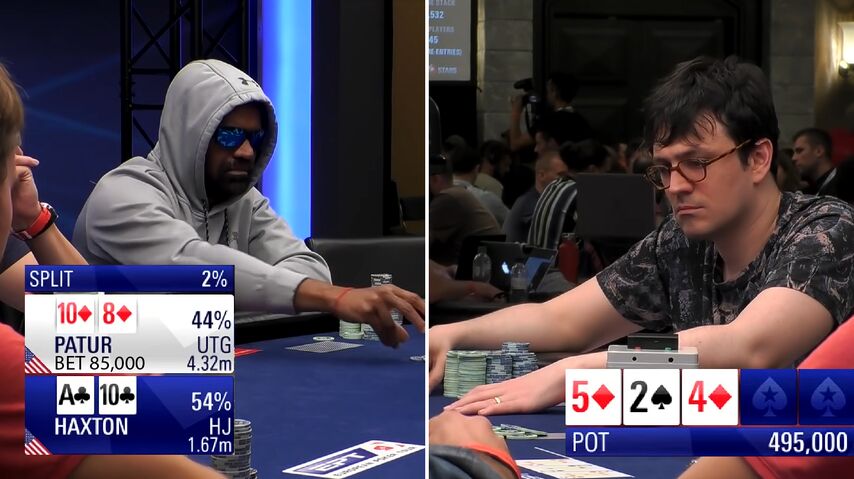What is a float in poker?
A float is when a player calls a bet with a weak hand – but plans to win with a bluff later. By “floating” on the flop (calling an opponent's flop bet), players can win the pot on the turn or river with a bluff.
This move can be successful because a lot of your opponents will continuation bet with weak hands, making them vulnerable to a float.
In this hand below, Daniel raises Phil on the flop, and Phil just calls. Why? He’s floating to bluff Daniel Negreanu later in the hand.

Let’s explain how a successful float works and how you can use floating in your poker strategy.
Here’s a Real Example of a Float in Poker
The definition of a float in poker is:
Calling a bet (or bets) with intentions to bluff the betting opponent later on in the hand.
When you float, you have equity, meaning that you might make a winning hand and win without a bluff. That being said, a bluff is usually the main plan, depending on which cards come on the turn and river.
Let’s see a real example.
Ike Haxton is up against Patur in the EPT Barcelona. Ike has A♣ 10♣ and Patur has 10♦ 8♦.
- Blinds are 30,000/60,000 and Patur opens the preflop action to 130,000 from UTG (under the gun). Ike calls from the HJ (highjack).
- The flop comes 5♦ 2♠ 4♦ and Patur sends out a very small continuation bet of just 85,000 into a pot of 410,000. Ike calls again.

- The turn is a 4♠, pairing the board but not changing much, except that it puts another flush draw on the board. Patur bets 165,000 into 580,000.
- Ike thinks for a little and then raises it to 600,000, making it 435,000 for Patur to continue.
This is the definition of a float. When Ike called the flop, he had very slim chances to improve his hand – and that’s definitely not the reason he called.

Ike was not attempting to hit an Ace or 3 – he was floating. He assumes that Patur is continuation betting with a wide range that often misses the range of a player who raised from an early position. In the end, he was partially correct, and Patur only had overcards and a flush draw.
That didn’t stop him from pushing all in a few moments after Ike’s 600,000 raise, forcing Haxton to fold. But Ike Haxton knows very well that you can’t expect every float to work.
Practice floating for free on partypoker by joining their hourly freerolls called Round the Clock events. The prizes range from $50-$200 and you’ll have 24 chances to win every day.
This is Why Poker Players Float
Now that we’ve gone over the definition of floating, we need to know why floating works.
Floating works because your opponents will continue betting (after some preflop aggression) even when they miss the flop. In the micro stakes, some opponents will blindly continue with overcards or draws with almost no equity – which you can target with floating.
It’s not just for targeting weak hands though; floating can always work against some of your opponent’s stronger ranges. Depending on your betting strategy and the board texture, you can sometimes float and bluff opponents.
Remember, floating is not the same as drawing. In a float, you expect that a bluff might be needed. If you’re just calling to hit one of your outs, you’re not technically floating – you’re drawing.
Head to the micro-stakes to practice your floats, but be strict with your bankroll, even if the stakes feel low. We’ve reviewed all of the best poker platforms and we’ll set you up with bonuses before you hit the tables.
- Increased first deposit bonus
- Increased rakeback and reloads
- Help with deposits and cashouts
- Access to private freerolls
- Round-the-clock support
5 Strategy Tips for Floating in Poker
1. You should float in heads-up pots and seldom try to float in multi-way pots. Your chance of successfully floating two or more players isn’t great. That’s either because your opponents will complete their draws (since their combined equity will be far greater than yours), or because one of them will get “sticky” and call your bluff. Keep things simple and float against singular opponents.
2. Make sure you have a plan! When you call on the flop, what will you do on the turn? You’ve got to be expecting the next bet and thinking about your next moves, whether you want to make a raise on the turn or the river.
3. Think about which turn and river cards are best for your float. Some cards will hit your range, other cards will hit your opponent's range. It’s possible to make the correct decision to float on the flop, but have your opponent hit them out on the turn. In general, you can use the cards that hit your range for your float strategy.
4. Try to give yourself some equity while floating, meaning that you should avoid zero-equity floats. Running bluffs with no equity will hurt your long-term win rate since you are essentially dead every time you are called. If you use hands with more equity, you’ll win sometimes, even when your float isn’t successful.
5. It’s ideal to float from in position (acting after your opponent). Floating out of position is significantly harder. You’ll have to make moves on the turn a lot of the time because if you check on the river, your opponent might just check after you. When your opponent bets the river, they’re usually value-betting rather than triple-barrel bluffing, which can also make a float more difficult. Playing in position makes floating much easier.


















